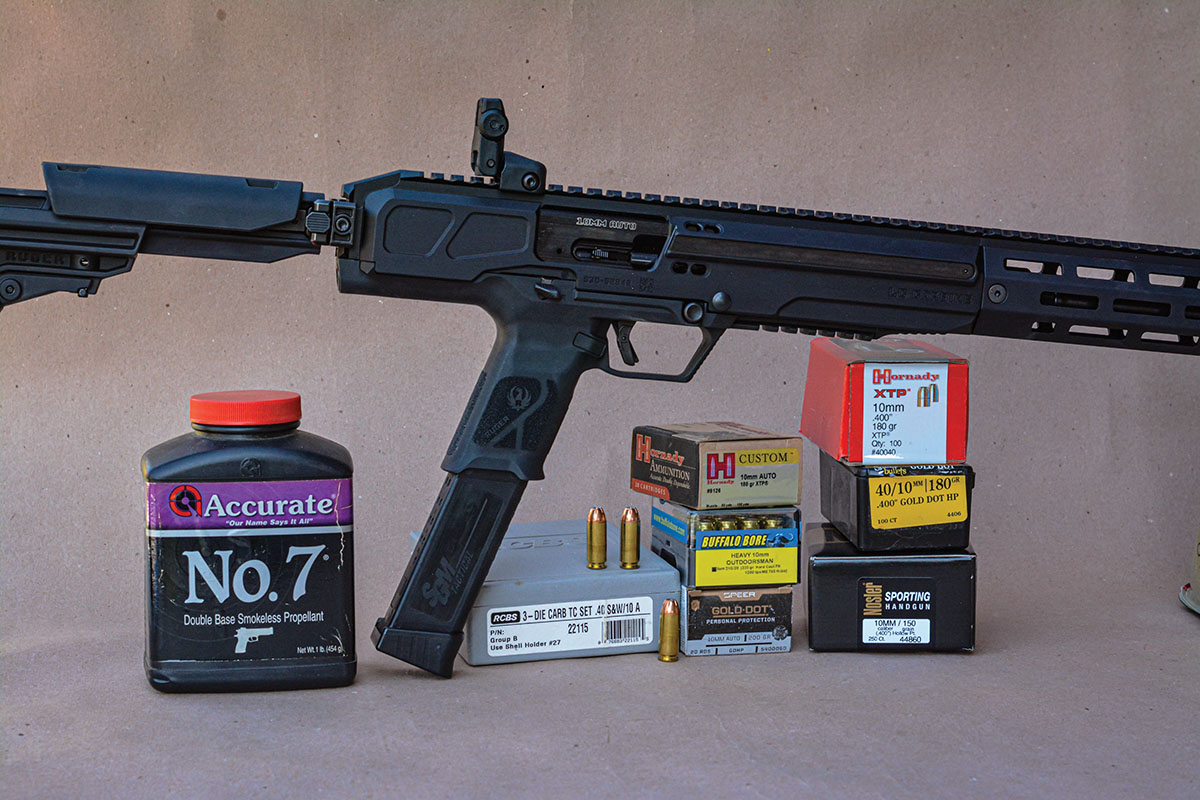
The new Ruger LC Carbine 10mm Auto was tested with factory loads and handloads.
Ruger has introduced a new compact, fast-handling carbine chambered in 10mm Auto that is very long overdue. The LC Carbine boasts robust, reliable mechanical engineering but also offers controls and ergonomics that are natural and easy to operate and comes standard with a 30-round magazine. In addition to accuracy, the 10mm offers greater power and range than other popular auto-loading pistol cartridges and is a capable deer cartridge. After the news release, Ruger and its distributors experienced a huge surge in orders, so it appears that the LC Carbine is already well received by shooters or anyone needing an auto-loading carbine chambered for a potent self-defense pistol cartridge. The LC Carbine is also offered in 5.7x28mm and 45 ACP cartridges.
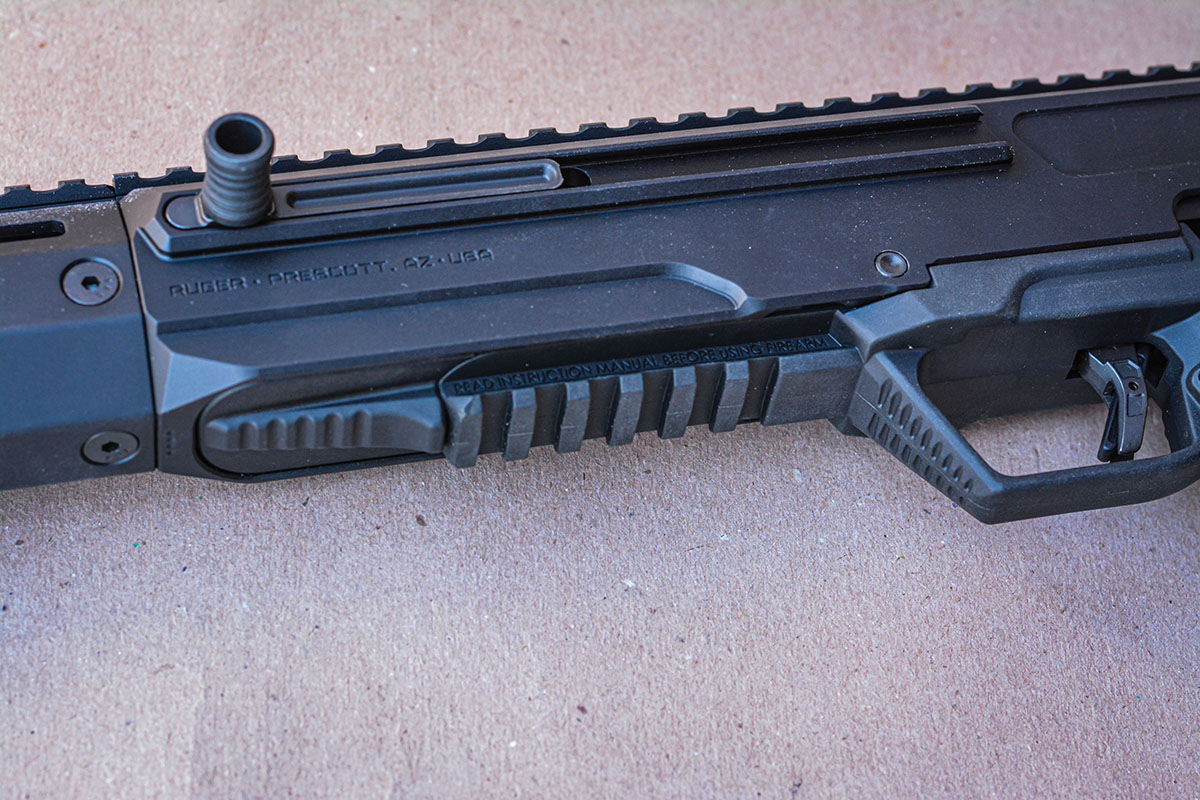
In addition to a top-mounted Picatinny rail, a Picatinny rail is located just forward of the trigger guard.

The 10mm Auto offers a notable velocity improvement when fired from a carbine versus pistols.
Before discussing details of the LC Carbine and how it performs, let’s look at the 10mm Auto cartridge. While Jeff Cooper is often credited for its development, it seems that his role was more of a consultant at first, but then later, he played a significant role in popularizing it after it was developed. Cooper generally credits Whit Collins for actually designing it during the 1960s. It was created by cutting off 30 Remington cases to .990 inch (which is a different case than the 30 Remington AR or the 35 Remington case). Collins used 38-40 Winchester and .401 Herters .400/.401-inch bullets and loaded his wildcat with Hercules (now Alliant) Unique powder. His custom Model 1911 and Browning Hi-Power pistols were referred to as “.40 Super,” “.40 Auto” and “10mm Auto.” Cooper was a combat veteran and savvy handgunner that had huge respect for the 45 ACP. However, his thoughts regarding this potentially new pistol cartridge was to increase the effective range (as compared to the 45 ACP) by offering higher velocity and better penetration on vehicles and obstacles. It would still be of large-enough caliber to not compromise terminal performance, while maintaining controllable recoil. It had to be compatible with pistols that are of practical weight and size, such as the 1911.

Factory 10mm Auto ammunition is offered by most companies and is hugely popular with modern shooters.
Collins .40 Super remained a wildcat until 1983, when Mike Dixon and Tom Dornaus finalized cartridge dimensions and worked with Norma to introduce a commercial 10mm Auto factory load that pushed a 200-grain jacketed bullet at 1,200 feet per second (fps). This team soon introduced the Bren 10 auto-loading pistol, but unfortunately, problems plagued that gun, and the company went bankrupt in 1986.
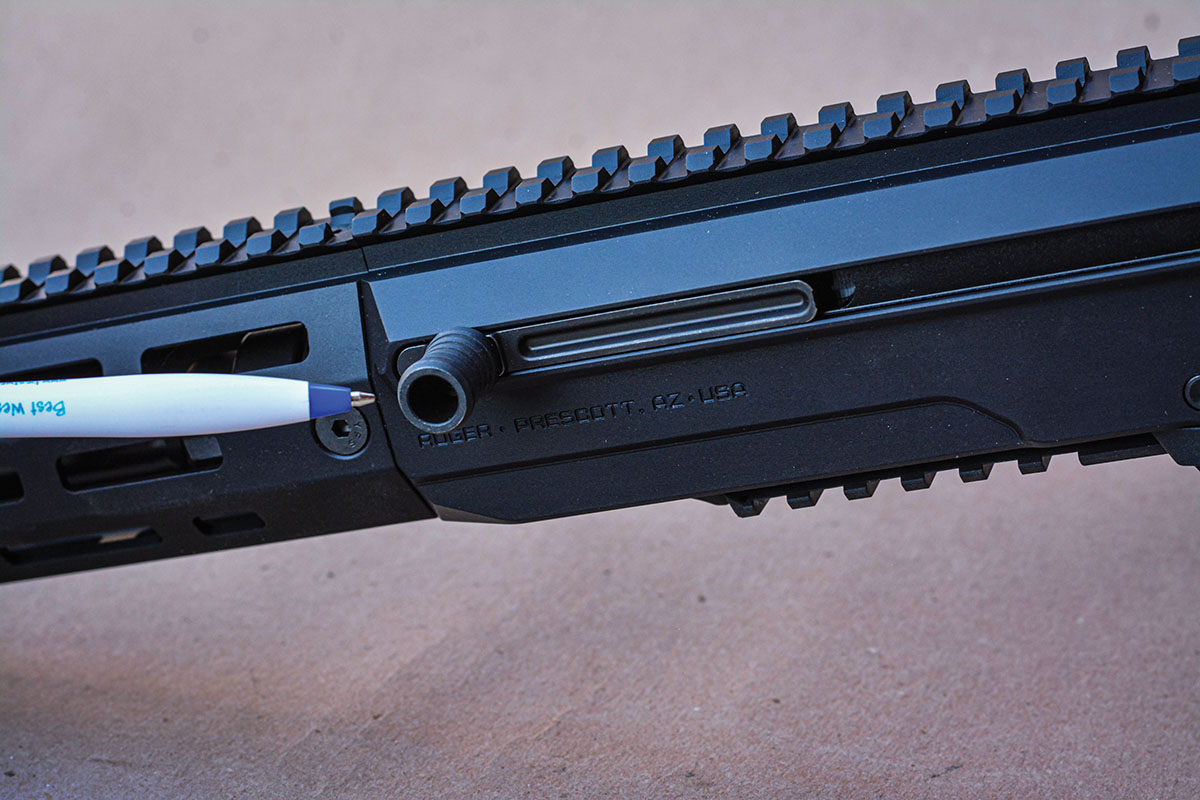
The charging handle is factory installed on the left side, which is ideal for right-hand shooters; however, it can be reversed to accommodate left-hand shooters.
Soon thereafter, Smith & Wesson and Colt began offering pistols. When the FBI discovered the 10mm’s many virtues, they officially adopted it in 1989, and its popularity surged with shooters and handgunners. For several reasons, the FBI soon expressed the need for lighter loads and requested a reduced load that became commonly known as the “FBI Lite,” which pushed 180-grain bullets from 980 to 1,030 fps. Smith & Wesson decided that they could shorten the case to .850 inch, switch to a small pistol primer and get the above ballistics from a cartridge that could be housed in many 9mm pistols. This became the 40 S&W in 1990 and was a huge success. It would seem that the 10mm’s power was no longer appreciated and it quickly fell from popularity. In fact, many predicted that it would soon become obsolete. While its popularity almost hit rock bottom, some of us still loved its many virtues, and eventually, it made a huge comeback. Currently, dozens of pistols are offered, and it has become one of the best-selling auto-loading pistol cartridges, even surpassing the 40 S&W.
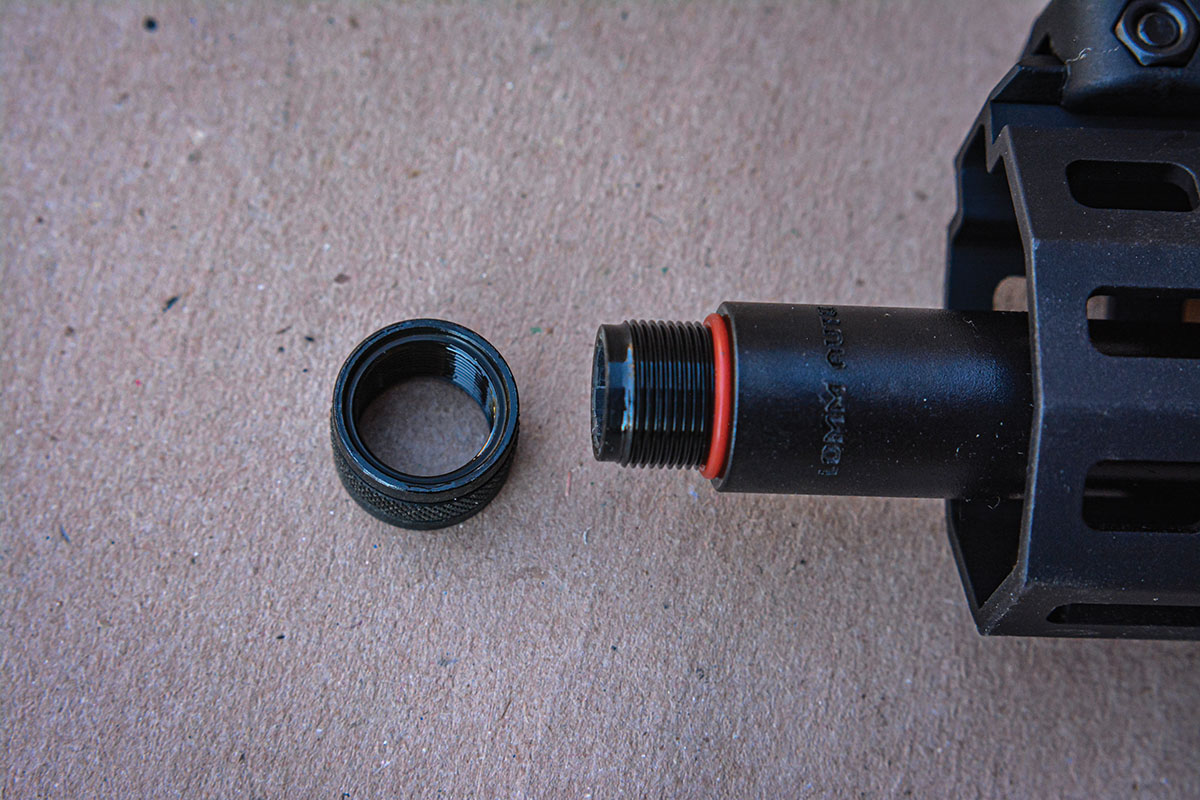
The 16.25-inch hammer-forged barrel is threaded .578x28 and comes standard with a protector.
While carbines in 9mm Luger and 45 ACP are popular, neither cartridge has the gas volume to increase the velocities by large margins when fired from the longer barrels. The 10mm Auto makes a comparatively larger velocity gain, especially when fired with loads that approach the SAAMI maximum pressure guidelines that are established at 37,500 psi. (Please note that very few factory loads are loaded to maximum pressures.) For example, when comparing velocities obtained from a Kimber Model 1911 with a 5-inch barrel to the velocities produced from the Ruger LC Carbine with 16.25-inch barrel, there is usually a 250 to 300 fps velocity increase with 150-, 165- and 180-grain loads. (More in a moment regarding velocity and performance.)
The LC Carbine receiver is alloy aluminum; the grip assembly and buttstock are polymer, while the bolt and barrel are constructed of steel, with the entire package being a flat black. The 16.25-inch barrel is hammer-forged, threaded .578x28 for accessories and comes with a protector. The weight is 7.4 pounds.


The LC accepts full-size Glock 10mm magazines and comes from the factory with a 30-round version. It should be noted that early Glock magazines that only feature one magazine latch slot can also be used; however, if these older magazines are used, the magazine release button cannot be reversed. The magazine is contained within the pistol grip, which is similar to the famous Uzi sub machine gun. This is a significant design feature as the shooter does not have to look at the gun to insert the new magazine when reloading; rather, the focus can stay on the surroundings. In essence, the magazine can be inserted into the bottom of the pistol grip by instinct or feel, which is a huge advantage if the gun is to be used in a defensive situation.

The front sight is adjustable for elevation and can be folded down.
Ruger refers to the bolt design as the “Ruger Secure Action” and with a “bolt over barrel design.” But those familiar with the famous Uzi will refer to this as a “telescoping bolt” or “overhung bolt.” Basically, the bolt wraps around and past the breech end of the barrel. The bottom line is that it results in a shorter overall design, allows for a very compact assembly and shorter firearm length. It’s a truly great design for pistol cartridges such as the 10mm Auto when housed in short sub-machine guns or carbines such as the LC. It is also noteworthy that the bore axis is very low. In fact, it is well below the center pivot point of the folding stock (a blueprint would be necessary to give an exact figure, but it’s around ½-inch lower). This results in very little muzzle rise during recoil; rather, recoil is mostly straight back, allowing rapid-fire bursts while keeping the gun on target.
As indicated, the LC Carbine is ergonomically designed to allow easy, natural operation, and the controls

The rear sight is a Ruger Rapid Deploy that folds down and is adjustable for windage.
accommodate both right and left-hand shooters. For example, as the Carbine comes from the factory, the charging handle is on the left side. It’s natural to keep the gun at the shoulder while inserting a magazine and working the charging handle (or bolt) with the left hand. However, the charging handle is also reversible for left-hand shooters. There is a fingertip push style slide release button (also known as bolt release) located just above the trigger and forward about 1 inch that allows the trigger finger to readily push to release the slide – a great option to drop the bolt in a hurry. There are two 1911-style safety levers for ambidextrous operation. There is a familiar blade safety located inside the trigger, similar to so many striker-fired pistols. With this combination of safety features, I would give it an A+ grade, especially considering how this type of firearm might be used. The magazine release is also reversible. The butt-stock is a folding-style and can be reversed for right- or left-side folding. It offers an adjustable length of pull from 12.60 to 14.60 inches. The overall length is 30.6 inches with the stock length-of-pull fully extended; however, with the stock folded, it measures 2 25⁄8 inches, allowing storage in small places.

“LC Carbine” is engraved on the side.
Other features include a full-length Picatinny top rail, a lower Picatinny rail located just forward of the trigger guard, an aluminum anodized hand guard featuring a 7 sided M-Lok – all of which accommodates a variety of mounting options for accessories. The front and rear sights are Ruger’s folding Rapid Deploy that offer adjustments for elevation (front sight) and windage (rear sight). The trigger pull breaks at 5.5 pounds.
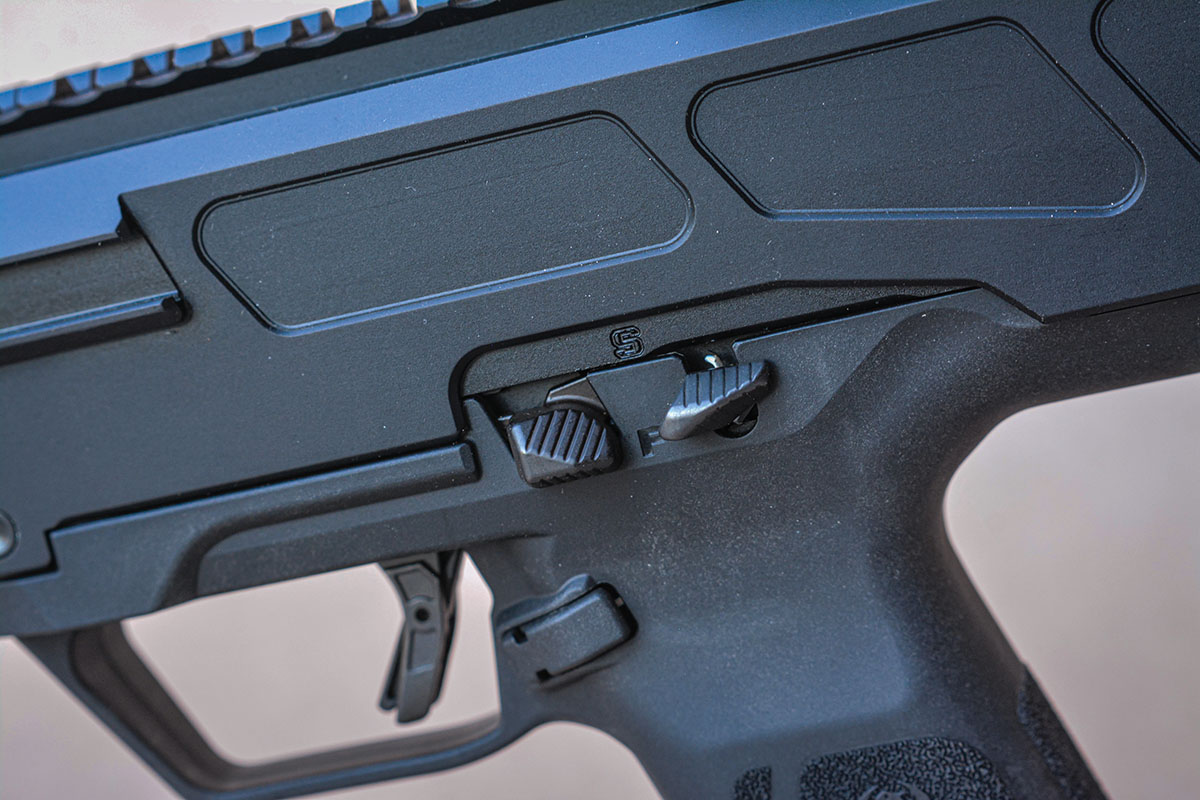
The thumb safety is a 1911 pattern and ambidextrous. The magazine release and slide release are likewise positioned for natural operation.
I don’t want to get too bogged down in the technical side of the mechanics and engineering, however, suffice to say that the LC is built like a tank, but still offers enough refinement to allow accurate shooting. For example, some of my testing was at 200 yards, and it was surprisingly accurate. In fact, it was easy to keep shots on a target similar in size to a deer’s vitals while shooting offhand.
As of this writing, around 700 rounds have been fired through the Ruger LC Carbine. It has fired at least seven different handload recipes that included 150 and 180-grain bullets and five different factory loads with bullet weights of 180, 200 and 220 grains. It has fed, fired and functioned with outstanding reliability. The only small occurrence happened with a comparatively low-pressure factory load (this brand was not included in the accompanying table) that failed to keep the bolt open on the last shot, but that was literally the only hiccup.

The trigger features a blade that adds to the overall safety of the LC Carbine.
Approximately 200 rounds of my handloads were fired before checking factory loads for function and accuracy. Using Hornady’s Custom 180-grain XTP load, velocity was 1,446 fps, and 50-yard groups averaged 1.10 inches using the factory aperture sights. The Speer 200-grain Personal Defense Gold Dot HP reached 1,223 fps and grouped into 1.35 inches. Lastly, the Buffalo Bore Outdoorsman 220-grain Cast FN load reached 1,320 fps, and three 5-shot groups averaged 1.60 inches.

With the stock folded, the LC Carbine only measures 22 5/8 inches long.
Before proceeding to handloads, it seems prudent to mention that industry maximum pressure guidelines for the 10mm Auto is established at 37,500 psi. However, very few companies actually load their ammo to this level due to some pistols that are throated excessively. In other words, they are concerned with the bottom of the case blowing out when the action begins to unlock. This is unfortunate, as 10mm performance potential is often left on the table, so to speak.

The LC Carbine readily accepts all full-size Glock 10mm Auto magazines, with a factory-supplied, 30-round magazine.
Moving on to handloads, which are all within SAAMI pressure guidelines, the Nosler Sporting Handgun 150-grain JHP bullet was tried with four powders. The highest velocity load consisted of 16.0 grains of Accurate No. 9 powder, capped with CCI No. 300 primer for 1,749 fps. Groups averaged 1.00 inch. However, switching to 12.9-grains of Accurate No. 7 powder velocity dropped to 1,653 fps, but groups tightened slightly at .95 inch. Switching to the Hornady 180-grain XTP bullet pushed to 1,481 fps using 12.2-grains of Accurate No. 7 powder, the group average was .90 inch. Again, I was pleasantly surprised by the accuracy that the LC Carbine delivered.

Brian obtained good accuracy with the LC Carbine at 50-yards using handloads containing the 180-grain Hornady XTP bullets.
The 10mm Auto is a great cartridge for pistols and carbines. However, it has enough merit in a carbine that it’s not necessary to have a pistol of the same caliber to be interesting, although having one might be a good enough reason to consider a pistol too! In addition to respectable power and modest recoil, muzzle report and flash are notably lower than most bottleneck rifle cartridges with a 16.25-inch barrel. The Ruger LC Carbine offers outstanding ergonomics, reliability, accuracy and is designed to accommodate right- and left-hand shooters. And it readily accepts about any accessory that might be needed. Private prices are notably less than the $1,049 MSRP. Regardless, considering the design and quality, it’s a bargain!



















